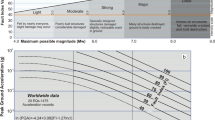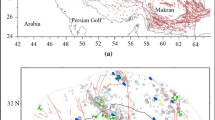Abstract
The organizations in different countries involved in seismic zoning modify the maps in response to various seismic events. The predictive ground motion is used in the analyses which may not be estimated using a single attenuation relation, because it is established on theoretical basis not with the actual ones and hence always errors are included in the analysis. However, the impact of faults is not considered in many of such seismic zoning efforts in several countries. An earthquake is generally triggered along the fault line; magnitude of generated earthquake depends on many factors, mainly the fault characteristics. Hence, the fault is the basic source of seismic activity and its presence and importance directly influences the seismic status of a region. In the present study a new term “fault importance index (FII)” is proposed which is a numeric value estimated from fault characteristics. The FII value for each of linear feature is calculated and relation is derived between the FII with earthquake intensity. The generated polynomial equations relate the past intensity spread with FII. The seismic risk zone map is then generated on the basis of FII. The developed seismic risk map has been compared to few earlier seismic maps and it can be used for design of buildings especially near the earthquake source.








Similar content being viewed by others
References
Acharya HK (1979) Regional variation in the rupture-length magnitude relationships and their dynamical significance. Bull. Seism. Soc. Am. 69:2063–2084
ANSS (2011) Advanced National Seismic System: an earthquake catalog ASC (2011). “ Historical Intensity maps”. www.asc-india.org.
Basu S, Nigam NC (1978) On seismic zoning map of India. Proceedings of the 6th Symposium of Earthquake Engineering, Roorkee, vol. I, pp. 83–90.
Bhatia SC, Ravi Kumar M, Gupta HK (1999) A probabilistic seismic hazard map of India and adjoining regions. Annali di Geofisica 42(6):1153–1164
BIS (2002) IS1893-2002 (Part 1). Indian Standard Criteria for Earthquake Resistant Design of Structure Part 1- resistant provisions and buildings. Bureau of Indian Standards, New Delhi.
Figuera J, Greco S, Ehrgott M (eds) (2005) Multiple criteria decision analysis, state of the art surveys. Springer, New York
GSI (2000) Seismotectonic atlas of India and its environs. Geological Survey of India
Gubin IE (1971) Multi-element seismic zoning (considered on the example of the Indian Peninsula). Earth Physics 12:10–23
Guha SK (1962) Seismic regionalization of India. In: Proceedings of the 2nd Symposium on Earthquake Engineering, Roorkee, pp 191–207
Henry C, Das S (2001) Aftershocks zones of large shallow earthquakes: fault dimensions, aftershock area expansion and scaling relations. Geophys. J. Int. 147:272–293
India Today, 1st March 2019, Tremors felt in Mumbai after earthquake hits Palghar in Maharashtra,www.indiatoday.in,;https://www.indiatoday.in/india/story/earthquake-tremors-maharashtra-palghar-mumbai-1467887-2019-03-01.
Iyengar RN, Raghukanth STG (2004) Attenuation of Strong ground motion in peninsular India. Seismological Research Letters 75(4):530–540
Jain SK, Murty CVR, Arlekar JN, Sinha R, Goyal A, Jain CK (1997) Some Observations on engineering aspects of the Jabalpur earthquake of 22 May 1997 (PDF), EERI Special Earthquake Report, EERI Newsletter, 32. Earthquake Engineering Research Institute
Jaiswal K, Sinha R (2006) Probabilistic modeling of earthquake hazard in stable continental shield of the Indian peninsula. Journal of Earthquake Technology, Paper No. 470, Vol. 43, No. 3, September 2006:49–64
Jaiswal K, Sinha R (2008) Spatial-temporal variability of seismic hazard in peninsular India. J. Earth Syst. Sci. 117(S2) November 2008:707–718
Kagan YY (1997) Seismic moment-frequency relation for shallow earthquakes: regional comparison. Journal of Geophysical research 102:2835–2852
Kaila KL, Rao M (1979) Seismic zoning maps of Indian subcontinent. Bulletin of Geophysical Research 17(4):293–301
Kandpal GC, Joshi KC, Singh J, Joshi DD, Singh BK, Ram S, Mishra RK, Chaube SP, Verma CS, Singh A, Sharma P, Mishra HP (2007) A report on seismic microzonation of Dehradun Urban Complex, Uttarakhand. GSI unpublished report
Katpatal YB, Shirkhedkar S (2013) Analysis of rock seismicity and present seismic risk zones within India. International Journal of Conceptions on Mechanical and Civil Engineering 1(1) Dec’ 2013; ISSN: 2357 – 2760
Katpatal YB, Shirkhedkar SS, Rathore SS (2012) Critical analysis of present status of seismic risk zones in India, proceedings, international conference on earthquake resistant design practices. MGR university, Chennai
Kettle LO, Mühlhaus H, Baillard C (2010) Study of localization limiters and mesh dependency in earthquake rupture. Phil. Trans. R. Soc. A 13 January 2010 368(1910):119–130
Khattri KN, Rogers AM, Perkins DM, Algermissen ST (1984) A seismic hazard map of India and adjacent areas. Tectonophysics 108:93–134
Kolat C, Doyuran V, Ayday C, Suzen ML (2006) Preparation of a geotechnical microzonation model using Geographical Information Systems based on Multicriteria Decision Analysis. Engineering Geology 87:241–255
Krishna J (1959) Seismic zoning of India. Roorkee University, Earthquake Engineering Seminar, pp 32–38
Kumar MR, Rao NP (2007) Site specific seismic hazard assessment of Jabalpur Central India. In: Sitharam TG, Bansal BK (eds) A Workshop on Microzonation, Indian Institute of Science, June 26 and 27. Interline Publishing, Bangalore, pp 7–8
Lee VW (1987) Influence of local soil and geologic site conditions on pseudo relative velocity response spectrum amplitudes of recorded strong motion accelerations, ReportCE 87-05, Dept. of Civil Eng., Univ. of Southern California, Los Angeles, California, USA.
Mahajan AK, Slob S, Ranjan R, Sporry R, Champati Ray PK, van Westen CJ (2007) Seismic microzonation of Dehradun City using geophysical and geotechnical characteristics in the upper 30 m of soil column. Journal of Seismology 11(4):355–370
Mishra PS (2004) Seismic hazard and risk microzonation of Jabalpur. Workshop on Seismic Hazard and Risk Microzonation of Jabalpur. National Geophysical Research Institute, Hyderabad, India
Mohanty WK, Walling MY (2008) First order seismic microzonation of Haldia, Bengal Basin (India) using a GIS Platform. Pure and Applied Geophysics 165(7):1325–1350
Mohanty WK, Walling MY, Nath SK, Pal I (2007) First order seismic microzonation of Delhi, India using geographic information system (GIS). Natural Hazards 40(2):245–260
N.D.M.A (2011) Development of probabilistic seismic hazard map of India. Technical Report
Nath SK, Thingbhaijam KS, Raj A (2008) Earthquake hazard in Northeast India – a seismic microzonation approach with typical case studies from Sikkim Himalaya and Guwahati city. J. Earth Syst. Sci. 117(S2):809–831
Parvez IA, Vaccari F, Panza GF (2003) A deterministic seismic hazard map of India and adjacent areas. Geophysical Journal International 155:489–508
Pegler G, Das S (1996) Analysis of the relationship between seismic moment and fault length for large crustal strike-slip earthquakes between 1977 and 92. Geophys. Res. Letters 23:905–908
Roberts, G.P., Cowieb, P., Papanikolaoua, I.,Michetti,A.M.(2004). Fault scaling relationships, deformation rates and seismic hazards: an example from the Lazio–Abruzzo Apennines, central Italy. Journal of Structural Geology 26 (2004) 377–398.
Saaty TL (2008) Decision making with the analytic hierarchy process. Int. J. Services Sciences 1(1):83–98
Searle MP, Law RD, Godin L, Larson KP, Streule MJ, Cottle JM, Jessup MJ (2008) Defining the Himalayan main central thrust in Nepal. Journal of the Geological Society, London 165(2008):523–534
Shaw BE, Scholz CH (2001) Slip-length scaling in large earthquakes: observations and theory and implications for earthquake physics. American Geophysical Union. Geophysical Research Letters:0094–8276
Somerville P (2000) Seismic hazard evaluation. 12th World Conf. on Earth. Eng. , Paper No. 2833
Stock C, Smith EGC (2000) Evidence for different scaling of earthquake source parameters for large earthquakes depending on faulting mechanism. Geophys. J. Int. 143:157–162
Tandon AN (1956) Zones of India liable to earthquake damage. Indian Journal of Meteorology and Geophysics 10:137–146
Ulusay R, Aydan O, Hamada M (2001) The behaviour of structures built on active fault zones: examples from the recent earthquakes of Turkey. Seismic Fault-induced Failures:1–26
Villamor P, Capote R, Stirling MW, Tsige M, Berryman KR, Martínez-Díaz JJ, Martín G (2012) Contribution of active faults in the intraplate area of Iberia to seismic hazard: the Alentejo-Plasencia Fault. Journal of Iberian Geology an international publication of Earth science 38(1):85–111
Walling MY, Mohanty WK (2009) An overview on the seismic zonation and microzonation studies in India. Earth-Science Reviews, 96, 1-2, September 2009:67–91
Warnitchai P, Sangarayakul C, Ashford SA (2000) Seismic hazard in Bangkok due to long-distance earthquakes. 12th World Conf. on Earth. Eng. , Paper No. 2145
Wells DL, Coppersmith KJ (1994) New empirical relationships among magnitude, rupture length, rupture width, rupture area and surface displacement. Bull. Seism. Soc. Am. 84:974–1002
Youngs RR, Coppersmith KJ (1985) Implications of fault slip rates and earthquake recurrence models to probabilistic seismic hazard estimates. Bulletin of the Seismological Society of America 75(4):939–996
Author information
Authors and Affiliations
Corresponding author
Additional information
Responsible Editor: Longjun Dong
Rights and permissions
About this article
Cite this article
Katpatal, Y.B., Shirkhedkar, S.S. Fault importance index (FII) as earthquake source criteria for seismic zonation: case study of India. Arab J Geosci 14, 186 (2021). https://doi.org/10.1007/s12517-021-06528-2
Received:
Accepted:
Published:
DOI: https://doi.org/10.1007/s12517-021-06528-2




